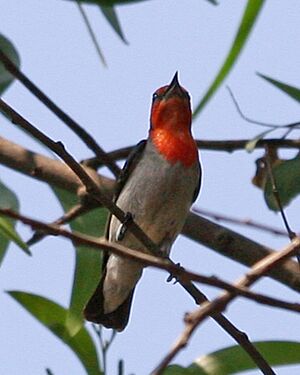Scarlet-headed flowerpecker facts for kids
Quick facts for kids Scarlet-headed flowerpecker |
|
|---|---|
 |
|
| Conservation status | |
| Scientific classification | |
| Genus: |
Dicaeum
|
| Species: |
trochileum
|
The scarlet-headed flowerpecker (Dicaeum trochileum) is a small, colorful bird found only in Indonesia. It belongs to the Dicaeidae family. You can often spot these birds in open forests, gardens, and even along the coast in places like Java and Bali.
This bird's population is currently stable. Because of this, experts have classified it as a species of Least Concern, meaning it's not currently at risk of disappearing.
Contents
What Does It Look Like?
The scarlet-headed flowerpecker is a tiny bird, growing to be about eight to nine centimeters long when it's fully grown. That's about the length of your finger!
Males
Male flowerpeckers are easy to spot because of their bright colors. Their head, back, and throat are a vibrant red or orange. Their wings are black with a hint of blue, and the tip of their tail is black. They have black legs and a grey beak.
Females
Female flowerpeckers have a lighter look. Their head and back are light grey or brown. However, they still have a bright orange or red rump, which helps tell them apart. Like the males, they have black legs, a grey beak, and a black tail tip. Their wings are lighter than the males' and don't have the blue color.
Young Birds
Young flowerpeckers, called juveniles, look more like the females. They are smaller and have lighter body colors. Their beak is light grey, their wings are pale brown, and their belly is a pale grey or yellow.
About Its Name
This bird belongs to the Dicaeidae family and the Dicaeum group. A French scientist named George Cuvier first named the Dicaeum group in 1817. The specific name Dicaeum trochileum was given by Anders Sparrman in 1789.
Where It Lives
The scarlet-headed flowerpecker lives only on a few islands in Indonesia. It is most commonly found on the islands of Java and Bali. Some have also been seen on Lombok, Sumatra, and in southeastern Borneo.
These birds love open woodlands, gardens, and mangrove forests. You can also find them along the seacoast and in low-lying areas of Sumatra. They usually live from sea level up to about 600 meters high. Many tourists visit the Taro region on Bali just to see this special bird!
How It Behaves
Its Call
You can often recognize the scarlet-headed flowerpecker by its unique call. It makes high, sharp, short notes. People describe its sounds as "zit-zit-zit" or "seeeeep…seeeeep." Each sound lasts for about two to three and a half seconds.
What It Eats
The scarlet-headed flowerpecker mainly eats small berries, insects, nectar, and pollen. It's often seen looking for berries in plants like milkweed and mistletoe. This small bird is quite brave and can perch low in trees. Its tiny size helps it move through thick branches to find its food. It will look for food alone or with a partner.
Reproduction and Life Cycle
The nest of this flowerpecker is small, about 7 to 8 centimeters long and 3 to 3.5 centimeters wide. It's built from grass and leaves, and sometimes even includes milkweed fibers. The eggs are white, sometimes shiny, and might have a dark red dot at one end. The bird lays its eggs in a large hole dug in the middle of the nest. Both male and female parents help take care of their chicks in the nest.
Moulting
Moulting is when birds shed their old feathers to grow new ones. Scarlet-headed flowerpeckers can moult throughout the year, but more of them moult in July. They tend to moult when there's plenty of good food available.
The time when these birds breed changes depending on where they live. In West Java, the breeding season is from January to October. In East and Central Java, it's usually from April to May.
Conservation Status
The scarlet-headed flowerpecker is listed as a species of Least Concern. This means its population is stable and not currently at risk. While human presence and noise can affect the bird's activity during the day, especially making them more active in the quiet mornings, these disturbances don't seem to harm their ability to reproduce or survive.


